10 Emerging New England Artists
For artists in the early stages of their careers, the challenges are plentiful: honing a visual language, closing the gap between taste and talent, and finding an audience. The ten artists featured here are overcoming such hurdles and producing compelling work on a consistent basis with little or no gallery representation.
What is most striking about this year’s list of emerging artists is the diversity of medium, background and age. Included are Penn Chan, a sailor from Maine; and Erik “Eaze” Williams, a former construction worker from Hartford, CT, who both embraced photography as new careers, one by earning an MFA from Yale and the other by teaching himself his craft. There is Barbara Ishikura, who returned to graduate school at 54, as well as the 28-year-old Lauryn Welch, whose education began as a child creating alongside her father in his studio. Youjin Moon and Misoo both found their creative voices in New England after growing up in Korea, while Cecilia Ackerman’s background in anthropology has inspired her paper tunnel books. Three artists on the list are examining issues of race, but through very different lenses: Nafis White creates sculptures that explore the role of hair in the lives of African American women; Becci Davis turns to archival materials to dissect her Southern heritage; and Darren Cole embraces social practice, teaching underserved communities about new technologies.
To select these artists, Art New England reached out to a nominator in each state—curators, teachers and individuals who interact with working artists, see new work regularly and possess a wide knowledge of the field. Special thanks to the following nominators for their recommendations and feedback: Heather Ferrell, curator and director of exhibitions at Burlington City Arts in Vermont; Nat May, curator and executive director of Hewnoaks Artist Colony in Lovell, ME; Dominic Molon, the Richard Brown Baker Curator of Contemporary Art at the RISD Museum of Art in Providence, RI; Craig Stockwell, artist and MFA visual arts director at the New Hampshire Institute of Art in Manchester, NH; Lisa Tung, executive director and curator of Bakalar & Paine Galleries at the Massachusetts College of Art and Design in Boston, MA; and Will K. Wilkins, executive director of Real Art Ways in Hartford, CT.
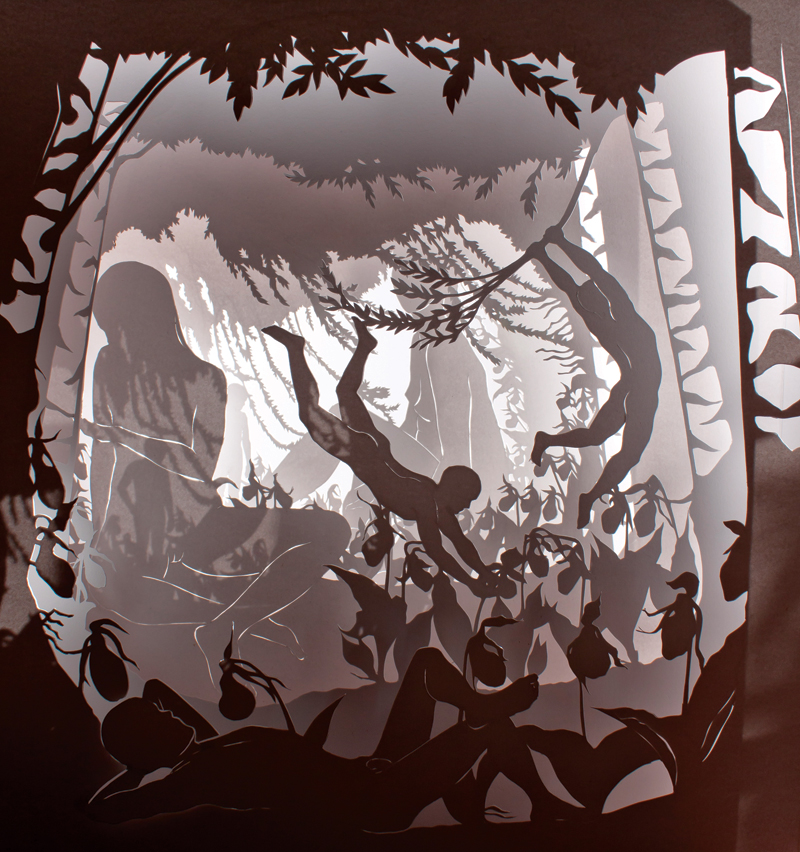
Cecilia Ackerman, We Fell Asleep, 2018, paper and natural light, 12 x 4 x 14″, hand-cut, collapsible, multilayered tunnel book. Courtesy of the artist.
CECILIA ACKERMAN
AUGUSTA, ME
“I learned about Cecilia when she attended the Hewnoaks residency in the summer of 2018. Her hand-cut, multilayered paper tunnel books evoke feelings of wonder by immersing human figures in natural environments. The depth, scale and attention to detail of the flora and fauna claim a position of dominance in a world in which humans play only a part,” says Nat May, curator and executive director of Hewnoaks Artist Colony.
A dual citizen of the U.S. and Denmark, Ackerman has two graduate degrees in anthropology, in addition to a BA in studio art and anthropology. “This background shapes the way I think about my materials and the narratives in my work,” explains the 32-year-old. “Often the characters in my tunnel books perform some kind of activity—like an anthropologist, you’re not sure what they’re doing or what it means, but you know it’s important.”
In Ackerman’s feminine, foreboding worlds, wilderness and domesticity coexist. “Flowers aren’t always sweet and sentimental. I’m less interested in the book form than I am in illusion. I’m captivated by the tunnel book as a pop-up—a place to play with scale and perspective.”
Ackerman’s creations also explore the slippery boundary between illustration and art. “I’m excited about the politics of making art that looks like illustration. I want the work to be ‘a-literal’, like illustration at its best.” Her aim is to “revalue illustration and its quiet political potential to instill wonder and possibility.”
In 2019 Ackerman plans to scale-up by enlarging a tunnel book into an immersive installation. She will also be a visiting artist at the University of Oklahoma in April.
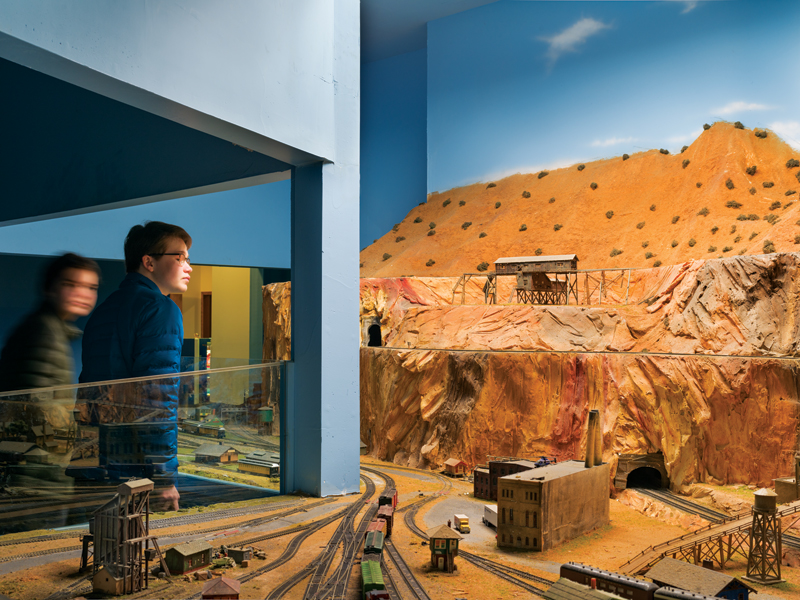
Penn Chan, Northlandz, New Jersey, 30 x 40″. Courtesy of the artist.
PENN CHAN
PORTLAND, ME
“I was immediately drawn to Penn Chan’s photographs for their understated and unsettling intensity. He rejects traditional documentary photography to investigate the human condition and our fraught relationship with the natural world,” says Heather Ferrell, curator and director of exhibitions at Burlington City Arts.
Chan, 29, was born in New York City. His father, who immigrated to America seeking asylum from Mao’s China, eventually found work at Bath Iron Works; Chan moved to Maine with his family at the age of ten, speaking only Cantonese. “Some of my classmates had never even seen an Asian person before in their lives,” he recalls.
He worked as a professional sailor before going to grad school at Yale. “I had only been interested in photography and making pictures for about five months before applying to get my MFA,” he says, “which was, in retrospect, a gift and a curse.”
Alienation is a theme running throughout Chan’s work. “Though I am the product of two different cultures, I have seldom felt a sense of belonging to either one.”
Chan’s photographs are both cinematic and documentarian in nature. He describes his images of scarred landscapes and individuals interacting with Maine’s frozen lakes as “anthropogenic,” “mysterious” and “utopic.”
When shooting, he tries to affect the setting as little as possible except when employing artificial lights. “This allows me to make pictures that are cinematic in tone, yet retain the complexities of reality, which is easily lost when a photographer maintains too much control over the content.”
Chan also works as an artist mentor at the Art Department in Portland, ME, a non- profit art studio catering to adults with developmental disabilities.

Darren Alexander Cole, Loving VS Us, 2013. The Loving v. Virginia case seems to resonate more than Cole and his wife would have imagined. They took this self-portrait to continue the movement, but also to mark a moment where it is possible for them to have their relationship. Courtesy of the artist.
DARREN COLE
CAMBRIDGE, MA
“Darren Cole is a multimedia artist whose work explores race and gender politics using paint, sound, and interactive video installations. Darren’s art practice is not a traditional one with one output, but rather has evolved into art and community building, engagement and education,” says Lisa Tung, executive director and curator of Bakalar & Paine Galleries at MassArt.
Born in Milwaukee, Cole has a love of technology as well as athletics. Before earning his MFA at MassArt, the 33-year-old received a track scholarship to attend the University of Wisconsin. His “daily art practice grew out of knowing you can see your skills grow if you practice every day.”
Cole’s love of filmmaking began in high school when a friend loaned him video equipment. While he also does commercial film work, his art practice centers on making technology accessible to communities who cannot afford it. By teaching students how to shoot their own videos or showing them the creative possibilities of affordable virtual reality headsets made of cardboard, he hopes that young people of all income levels will be inspired to embrace technology-based mediums, as he once did.
Inspired by the collaborative model of the music industry, Cole enjoys creating with others. This merging of pedagogy and social practice is his primary creative medium. The end result is not a specific piece of work that can be easily documented, but is more akin to throwing a stone into a pond—the impact and ripple effects created by Cole’s outreach are what matter most.
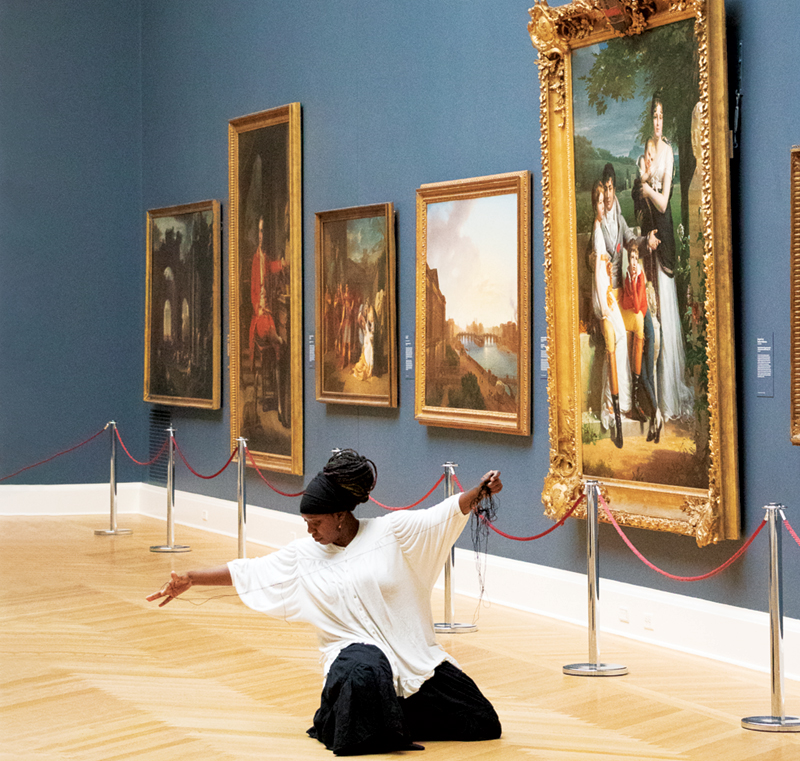
Becci Davis, A Counter Monument FUBU, a durational performance. By embroidering handmade textiles, the artist attempted to repair the ancestral wounds of American history, ruptures incurred through the continued presence of Confederate monuments in her home state. Her labor constructs living monuments commemorating the lives of enslaved Americans whose identities and contributions have gone largely unacknowledged. The performance was held in the Grand Gallery, Pendleton House, and the European and Greek galleries of the RISD Museum. FUBU was performed in response to the In the Shadow of Dixie project. Photo: Nafis White.
BECCI DAVIS
WAKEFIELD, RI
“Becci Davis’s…fearlessly intelligent performance-based work…challenges (problematically still) accepted relationships between history, monuments and race specific to the African American experience and America’s dark legacy (and ongoing reality) of white supremacy,” says Dominic Molon, Richard Brown Baker Curator of Contemporary Art at the RISD Museum of Art.
Born in Fort Benning, GA, Davis finds creative inspiration in her encounters with nature, as well as her personal experiences as a daughter, mother, Southerner and descendant of both enslaved Americans and those who exploited them.“
I love to learn, so research is the element of my practice that I get most excited about,” the 40-year-old explains. “The women in my family are…recorders and keepers of recipes, stories, portraits and traditions.” Davis follows their example, working across media, collecting images, documents and oral narratives. These collections are then combined with the artist’s own response, creating a new history and personal geography. Her work with found objects and archives finds expression in installations, time-based media and social practice.“
I am currently working on a project titled In the Shadow of Dixie,” says Davis. “It centers on the role Southern women played in establishing and funding Confederate monuments in eight different Georgia cities…The project also employs the practice of grassroots organizing in an attempt to dismantle the monuments and replace them with memorials honoring local enslaved populations.”
Davis is the recipient of the 2018 Providence Public Library Creative Fellowship, the Rhode Island State Council on the Arts Fellowship and the St. Botolph Emerging Artist Award. In the Shadow of Dixie is in the exhibit Visualizing Protest at the Stamp Gallery in College Park, MD, on view through March 29, 2019.

Barbara Ishikura, Odalisque with Cigarette and Beer, 2019, acrylic and mixed-media on paper, 27 x 60″. Courtesy of the artist.
BARBARA ISHIKURA
BOLTON, MA
“Like the pop artists before her who used popular culture or comics to sugarcoat a bitter message, Barbara’s cartoony canvases draw the viewer into empathizing with the pain and suffering portrayed while exploring gender, feminism and sexual politics, and mortality,” says Lisa Tung, executive director and curator of Bakalar & Paine Galleries at MassArt.
Ishikura’s large-scale paintings are provocative, comical and voyeuristic, often portraying an autobiographical female character created by the 56-year-old artist. Her newest series addresses sexuality and the aging female body.”
I get most excited by the content of my work, which is an investigation and expression of my experience living in a female body,” says the painter. “I enjoy studying images of women in art history, by male and female artists.” She is currently studying the work of artists, such as Suzanne Valadon and Berthe Morisot, “and how they chose to represent the female body in comparison to their male counterparts such as Degas and Gauguin.”
Ishikura speaks Japanese and for 20 years taught English to foreign students at the university level. “At the time, I didn’t believe it was possible to have a life as an artist,” she explains from her residency at MASS MoCA. “Over time, the need to make art just haunted me; I tried to ignore it, but the voice was always there. At age 54, I entered an MFA program in painting at MassArt. The benefit to attending an MFA program as an older adult is that it quickly became very clear to me what I wanted my paintings to be about, conceptually. I understood that I had a lifetime of experiences to make artwork with and this was my strength.”
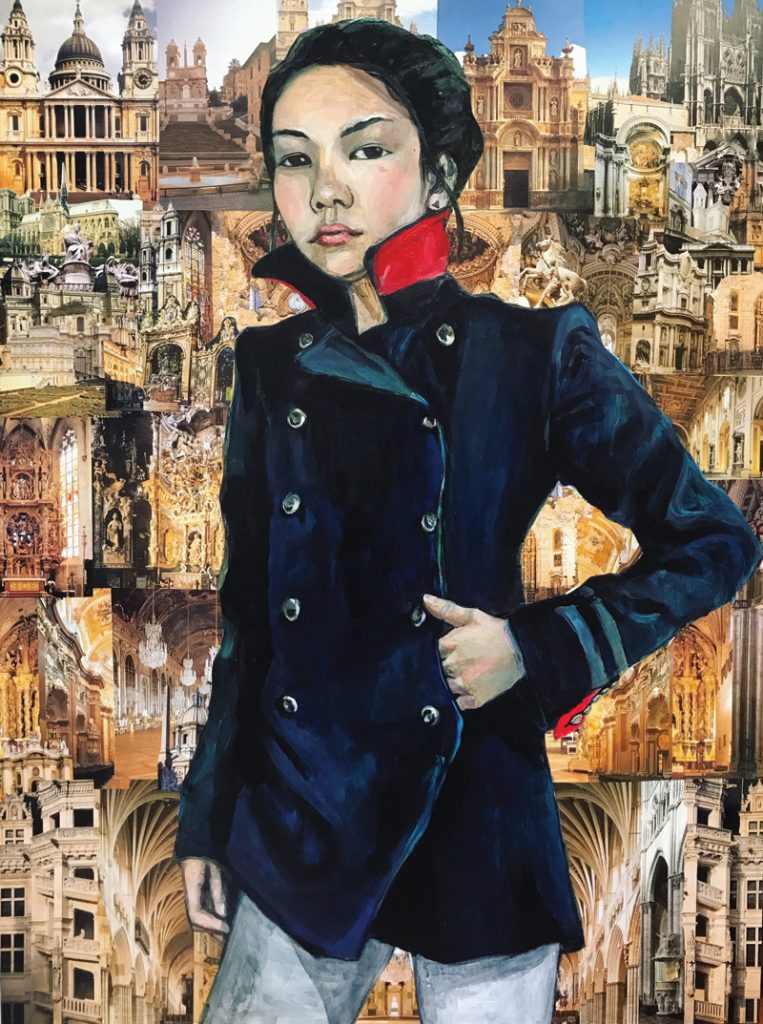
Misoo, The Giant Asian Girl 10, 2018, 36 x 48″, acrylic paint and collage on panel. Courtesy of the artist.
MISOO
SHELBURNE, VT
“Misoo’s drawings are beautiful and provocative. Embodying themes of dislocation, trauma and empowerment, her large-scale ink and pencil drawings on rolls of paper defy gravity as they swirl and leap off gallery walls. Misoo’s aesthetic vision is as refreshingly unique as it is emotionally charged,” says Heather Ferrell, curator and director of exhibitions at Burlington City Arts.
Misoo’s path to Shelburne, VT, was winding. Born in the Bronx in 1980, she moved back to her parent’s homeland of South Korea when she was only a year old. Seventeen years later, she returned to the U.S., wanting to use painting as a mode of emotional communication and storytelling.
Working in both ink and pencil, Misoo uses symbols and nonrepresentational marks as a way to process and express her repressed memories of sexual abuse. “With the personal language…I can show vulnerability and strength at the same time.”
The artist’s large-scale, fluid drawings are enveloping. “By folding the paper, I am able to control and recreate the space of my memory. The dragged part of the Yupo paper stretches out to the viewers and invites them into the space I created.”The idea of redemption flows through Misoo’s art. While her themes are serious, she believes the beauty of her techniques make the work approachable. “Creating and exhibiting this body of work, I feel as if I have gained control over the previously overpowering memories that used to define me.”Misoo’s work can be seen in the upcoming show Pangs at the New City Galerie in Burlington, VT, on view through April 17 and at GreenTARA in North Hero, VT, this June and July.

Youjin Moon, still from Ganymede, 2016, 9-minute video. Courtesy of the artist.
YOUJIN MOON
BOSTON, MA
“Nature, science, biology and the arts all intersect in Youjin’s uninhibited, wild and visionary spaces. Drawing upon her expertise in many disciplines and not being afraid to experiment or invent new processes allows Youjin to create otherworldly cinematic environments that are truly new.…[Her] painterly, experimental 4D work is truly an enveloping experience,” says Lisa Tung, executive director and curator of Bakalar & Paine Galleries at MassArt.
Moon’s poetic, layered videos, paintings and drawings explore a realm that hovers somewhere between dreams and reality. Her fluid, cosmic creations are personal, yet familiar. “After having a surreal dream about exploring outer space,” she says, “I recently started writing a dream journal and making spontaneous drawings of my dreamscapes on my iPad.”
Moon was born in Busan, South Korea, and received a BFA in Oriental Painting from Hongik University in Seoul before earning two MFAs in Painting and Film/Video from MassArt. “My background in traditional Korean painting and experience as an abstract painter inform my interest in time-based abstraction,” she explains. “I apply a painter’s eye for color, composition and texture to my video work. My multidisciplinary practice has given me new insight into ways to physically alter digital images and develop surface tension between the organic and digital…This allows me to bring tactile qualities into my digital compositions.”
Moon’s latest endeavor is a trilogy of videos reimagining migration, icescapes and an urban environment—a meditation on utopian desires and futuristic visions. Her work has been shown at the deCordova Biennial, as well as numerous film festivals, including the Stuttgarter Filmwinter Festival for Expanded Media in Germany, January 2019.
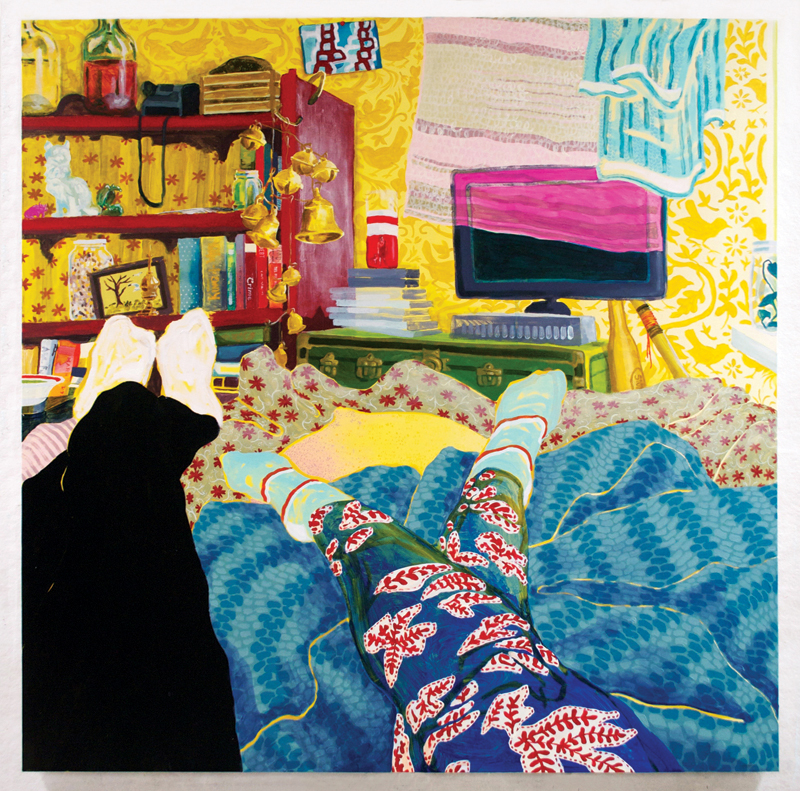
Lauryn Welch, Scherzo, 2018, acrylic on canvas, 48 x 48″. Courtesy of the artist.
LAURYN WELCH
PETERBOROUGH, NH
“Lauryn is doing something new, strange and boisterously pleasurable with paint, film, painting and figuration. In [her] work everything is questioned and redeployed. The figure is painted, as is the background. The two are seamlessly melded. The work is uncanny and it reinvigorates painterly questions…” says Craig Stockwell, MFA visual arts director at the NHIA.
Welch grew up in the Monadnock region of New Hampshire “surrounded by studios, artwork, artists and critique” thanks to her father, artist Chuck Welch. She describes herself as “an unabashed color nerd.” Her work explores how color and pattern are used on the body to express or conceal one’s identity in relation to one’s environment and was featured on the March/April cover of Art New England in 2015. “I love the changeability of color. No one can pin it down,” says the 28-year-old. “It’s so contextual and tangled up in language, culture, experience and visual perception. A color can only be defined by the colors around it, and that’s so weird and exciting to me.”
Welch strives to “make work that feels honest” and “to speak honestly, simply and transparently about it. There’s a lot of pressure in this field to write and paint in a way that is theory-heavy and very opaque, or to hit certain buzzwords and topics, and I don’t see that serving me or my community very well… I just want my work and myself to be accessible beyond the art world bubble.”
An appreciation for accessibility is also evident in Welch’s day job as gallery manager at NHIA’s Sharon Arts Gallery. She is curating two mail-art shows at NHIA, which run through April 14, including a retrospective of her father’s work, Chuck Welch: Archives, Correspondence, and Mail Art, 1980–Present.

Nafis White, Blackberry, 2018, hair, embodied knowledge, audacity of survival, ancestral recall, pony beads, Swarovski crystals, bobby pins, 3′ x 3′ x 6″. Courtesy of the artist.
NAFIS WHITE
PROVIDENCE, RI
“[Nafis White’s] recent works have compellingly explored the critical importance of hair—and the styling thereof—to African American culture and experience,” says Dominic Molon, Richard Brown Baker Curator of Contemporary Art at the RISD Museum of Art.
Whether she is reimagining intricate Victorian hair weavings using African American hair and styling techniques or making hundreds of paper roses for an installation,What Cannot Be Said Will Be Wept, memorializing 1206 black women shot by police in a single year, White’s love of her materials shines through. “Play is essential in my creative process as is the use of intuition and curiosity to lead the work while centering levity,” she explains. “I am not off-put by failure, because that is what keeps me nimble and encourages me to continue to try new things, new combinations, new processes.”
“Her provocatively tactile sculptures and installations address complex notions of race, gender, identity, and political realities and ideals through personal narratives,” says Molon.
White, who holds an MFA and BFA from RISD and is a member of the International Guild of Knot Tyers, is currently collaborating with her partner, García Sinclair, on a multi-day performance work at the RISD Museum on view March 29 to April 5, 2019. “The piece is a 400-foot sculpture titled Strand that will be…made of hair and woven by a team of weavers,” White says. The piece commemorates the span of 400 years since the enslavement of Africans in the U.S. to the present.
“That is my challenge,” White writes in Nailed Magazine, “to at once witness, uplift, communicate, challenge and speak from my experiences and those of my community and give voice and visuals to those moments in our history that will hopefully resonate and stay with viewers long after they have walked away from the work.”

Erik Williams, Eyes of the Preacher’s Child. Courtesy of the artist.
ERIK “EAZE” WILLIAMS
BLOOMFIELD, CT
“No bragging, just modest acts of witness. I discover something about where we live that I haven’t seen ’til he’s shown it to me. I love his work,” says Will K. Wilkins, executive director of Real Art Ways.
A Hartford native, Williams is a self-taught photographer who traded in his career as a construction worker in order to pursue visual art. In late 2017, he had his first solo gallery how, Sad And Beautiful World, at Real Art Ways in Hartford.
Eschewing the “distracting” saturation of color photography, the artist’s gritty, black-and-white photographs of stray animals, kids on bikes and the homeless commemorate lives that are too often invisible. “I look for the beauty in any and everything that most overlook,” says Williams. “My choice of subject is anything organically appealing to my eye, whether it’s a kid sleeping on the city bus or a reflection of a building from a puddle.”
The 35-year-old embraces the improvisational nature of street photography and loves “the opportunity it creates to capture honest moments.” Wandering Hartford’s neighborhoods with his camera allows him to connect with people from all walks of life, as well as the city he calls home. “I feel like I have a certain connection with my subjects because I can relate to their struggle in a way,” Williams explains. “I too have had my share of tough times.”
Williams’s raw, poignant photographs are quietly affecting. “Sometimes you look at people in these situations and feel pity for them,” Williams told the Hartford Courant in 2017. “You think they hate life, that their outlook must be the worst. But it is beautiful…In these communities you still see beautiful things.”
A special thanks to all of the nominators and artists for sharing these stories and insights with Art New England. To learn more about the artists, their work, and upcoming shows, please visit their websites below.
Cecilia Ackerman Augusta, ME, ceciliaackerman.com
Penn Chan Portland, ME, pennchan.com
Darren Cole Cambridge, MA, mycoleccion.com
Becci Davis Wakefield, RI, beccidavis.com
Barbara Ishikura Bolton, MA, barbaraishikura.com
Misoo Shelburne, VT, misoo.org
Youjin Moon Boston, MA, youjinmoon.com
Lauryn Welch Peterborough, NH, laurynwelch.com
Nafis White Providence, RI, nafiswhite.com
Erik “Eaze” Williams Bloomfield, CT, blackframevision.com
Michelle Aldredge is a writer, designer and founder of the arts blog, Gwarlingo. She has been named a “Top 100 Artist, Innovator, Creative” by Origin magazine. She is also co-author of Mirror Mirrored: A Contemporary Artists’ Edition of 25 Grimms’ Tales.
